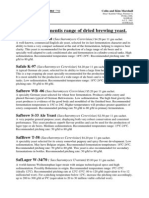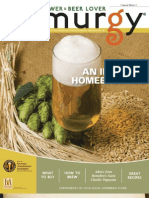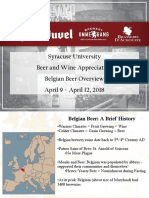TN 109 Beer Hop Extraction
TN 109 Beer Hop Extraction
Uploaded by
MaxPostvanderBurgCopyright:
Available Formats
TN 109 Beer Hop Extraction
TN 109 Beer Hop Extraction
Uploaded by
MaxPostvanderBurgOriginal Description:
Copyright
Available Formats
Share this document
Did you find this document useful?
Is this content inappropriate?
Copyright:
Available Formats
TN 109 Beer Hop Extraction
TN 109 Beer Hop Extraction
Uploaded by
MaxPostvanderBurgCopyright:
Available Formats
process.
Isomerized -acid bitterness
BEER HOP EXTRACTION disintegrates during storage, since -
RUDY BASKETTE, SUPERCRITICAL FLUID
TECHNOLOGIES, INC
acids emerge during the later stages of
the brewing process; they provide a
more biting bitter flavor.
INTRODUCTION Hops have certain flavor profiles
ranging from citrusy, woodsy, spicy, or
The practice of beer brewing is fruity. The essential oils aspect of the
seven thousand years old and has out hops is where these different scents lie.
survived most of the cultures that drank Adding hops in to the early stages of
it. While the ancient Babylonians, boiling wort degrades all essential oils.
Romans, Assyrians, and Incan cultures So, dry hops are added to the end
can no longer partake in the nectar of stages of boiling wort or after the wort is
the gods, striving to brew the best beer cooled to harness the scents in the
is still a prevalent goal. One of the beer.
methods to improve the flavor of a beer To extract maximal flavor profiles,
is to enhance the intensity of the hops. SFT developed a lab-scale method
Supercritical carbon dioxide hop using the SFT-110 SFE to extract hop
extraction is a method to obtain hop oil oil. A two-step supercritical carbon
extracts with high concentrations (both dioxide extraction allows the separation
yield and purity) and quality (less of the aromatic/essential oils from the
artifacts). bittering agents in
There are 3 major chemical hops. The SFT-110
components to hops: produces a natural,
unaltered oil extract
that amplifies natural
hop flavor profiles.
Using this method,
brewers can acquire
a truly enhanced
flavor for their customers to enjoy.
The SFT-110 utilizes pressurized
-acids, -acids, and essential oils. carbon dioxide, allowing extraction to
When hops are added to boiling wort, - take place in room temperature
acids such as humulone, thermally environments, so a purer, less thermally
degrade to their iso- form. Isomerized decomposed extract is generated.
- acids induce bitter flavoring for the Carbon dioxide is also advantageous,
beer, as well as providing a slight because it does not introduce any
antibiotic effect against gram positive residual organic chemicals, meaning
bacteria. Unlike -acids, -acids do not that all extracts are safe to consume.
isomerize during the wort boiling CO 2 extraction extends the life of
process. -acids, such as lupulone, hop flavors. Hop pellets easily degrade,
leisurely oxidize during the fermentation but the integrity of a hop oil extract can
and storage phases of the brewing be maintained in a veritable climate.
Carbon dioxide extraction using the Brewer hop pellets were utilized for this
SFT-110 can separate the oils in a experiment. All the samples were
clean, energy efficient fashion. harvested in 2011 and bought from
Label Peelers Inc.
EQUIPMENT Weigh 20 grams of hop pellets on
Analytical Balance an analytical balance. Grind up pellets
SFT-110 SFE Unit to 1mm x 1mm and load into the SFT
SFT 100 cc Sample Vessel 100 cc Sample Bag. Place the SFT 100
SFT 100 cc Sample Bag cc Sample Bag into a SFT 100 cc
sample vessel (10kpsi, 200C
operation).
MATERIALS Seal the vessel and set into a SFT-
Hop pellets 110 SFE unit. Two fractions of oil will be
2 SFT Collection Vials collected via
1 SFT Vent Tube multiple (10)
soak and
dynamic flow
steps. Place
a chilled pre-
weighed SFT
collection vial
on the flow
line. Extract
the samples
according to the following parameters:
EXTRACTION PARAMETERS
Two fractions of oil will be collected
via multiple soak and dynamic flow
cycles according to the guidelines
below.
FRACTION 1: ESSENTIAL OIL EXTRACT
Figure 1. SFT-110 SFE Unit
Pressure: 2180 psi
Temperature: 40C
EXPERIMENTAL PROCEDURE CO 2 Flow Rate: 4mL/min
A simple two-step SFE extraction 10 static and dynamic steps for
method using the SFT-110 was 15 minutes apiece
employed to separate aromatic from
bitter components of hops. Four After Fraction 1, change out the
samples: Sorachi Ace, Summit, U.S. collection vial and replace with another
Brewers Gold, and U.S. Northern clean, tared vial for fraction 2 products.
commonly used for its lemon and dill
FRACTION 2: BITTERING COMPOUNDS essence in IPA and Pale Ale, has the
Pressure: 4350 psi highest total yield of products. Summit,
Temperature: 40C U.S. Northern Brewer, and U.S. brewer
CO 2 Flow Rate: 4mL/min Gold respectively followed in yield
10 static and dynamic steps for product.
15 minutes apiece
After Fraction 2, you can remove the
SFT 100 cc sample bag from the SFT-
100 cc vessel and proceed to clean the
SFT-110 SFE.
RESULTS
The aromatic extracts will yield a
distinctly different color product than the
bittering extract. Fraction 1, the
essential oil and aromatic hop Figure 2. SFE-CO 2 Extraction of Sorachi Ace
extraction, will yield a bright yellow
product. Fraction 2, the bittering Figure 2 is the extraction yield
compound extraction product, will yield results for Sorachi Ace at 2180 and
a dark yellow, light brownish color. 4350 psi. Basically this table is serving
to indicate the yield of SFE CO 2 hop
Hop Type Yield @ Yield @ Total extraction at specific time intervals.
2180 psi 4350 psi Yield
(g/100 g) (g/100g)
Sorachi Ace 13.65 9.79 23.44
Summit 12.94 8.31 21.25
U.S. Brewer's 9.89 8.66 18.55
Gold
U.S. Northern 12.20 4.59 16.79
Brewers
Figure 3. GC/MS Sorachi Ace extract @ 4350 psi
Table 1. SFE-CO 2 Hop Variety Extraction Yields
Figure 3 is the GC/MS
Table 1 is the extraction yield chromatograph of Sorachi Ace extract at
results for the 4 hop types at 2180 and 4350 psi. Notice the presence of
4350 psi. These particular hops were lupulone and lupulone constituents, i.e.
chosen specifically for their high oil -acids.
content. As you can see Sorachi Ace,
CONCLUSIONS
Aromatic and bitter components of
hops can be extracted using the lab-
scale SFT-110 SFE Unit. Supercritical
CO 2 extraction can isolate specific
components with slight adjustments to
temperature or pressure. Regarding
hops, aromatic compounds/essential
oils are extracted at 2180 psi, and bitter
components are extracted at 4350 psi.
Sorachi Ace yielded the highest
aromatic and bitter fractions. GC/MS
analysis of Sorachi Ace bitter oil fraction
yielded lupulone and lupulone
constituents. These compounds are
solely characteristic of bitter fractions.
Distinctive aromatic compounds, i.e.
humulone or its isomers were present in
the GC/MS analysis of Sorachi Ace at
2180 psi, indicating that the 2-phase
extraction was indeed successful in
separating aromatic and bitter
components.
REFERENCES
Zoran, Zekovic, Pfaf-Sovljanski Ivana,
and Grujic Olgica. "Supercritical Fluid
Extraction of Hops." Journal of the
Serbian Chemical Society 72.1 (2007):
81-87.
<http://www.doiserbia.nb.rs/img/doi/035
2-5139/2007/0352-51390701081Z.pdf>.
You might also like
- Three Floyds Brewery Business PlanDocument52 pagesThree Floyds Brewery Business Planchinsi100% (1)
- Project Report On JW MarriottDocument41 pagesProject Report On JW MarriottLovlesh Ruby60% (30)
- Zymurgy Bob's Making The CutsDocument2 pagesZymurgy Bob's Making The CutsTy Fitwilly100% (1)
- Activity Design For Team BuildingDocument4 pagesActivity Design For Team BuildingAllysa Marie Borlado100% (6)
- Mastering The BJCP ExamDocument17 pagesMastering The BJCP Examhunteramor100% (2)
- DCL YeastDocument2 pagesDCL YeastACBNo ratings yet
- Castle Malting Weyermann Malts Equivalents Oct 20131Document2 pagesCastle Malting Weyermann Malts Equivalents Oct 20131turbonatics0% (1)
- Enzymes in Brewing - Biokemisk ForeningDocument9 pagesEnzymes in Brewing - Biokemisk ForeninggutaviedNo ratings yet
- Name / Origin Fermentis Imperial Omega White Labs Wyeast CommentsDocument1 pageName / Origin Fermentis Imperial Omega White Labs Wyeast CommentspintadbNo ratings yet
- Beer Brewing Recipes: American Lite Lager EditionFrom EverandBeer Brewing Recipes: American Lite Lager EditionRating: 2 out of 5 stars2/5 (1)
- Late Hop & Hop OilsDocument3 pagesLate Hop & Hop OilsBill LimaNo ratings yet
- Beer Judge Certification Program: Guide To Beer StylesDocument30 pagesBeer Judge Certification Program: Guide To Beer StylesazbrewerNo ratings yet
- Craft: The Brewers Association Guide To AmericanDocument16 pagesCraft: The Brewers Association Guide To AmericanMar KamonNo ratings yet
- CBC Online Seminar Presentation Draught Beer Quality Workshop Addressing Draught Beer Dispense IssuesDocument40 pagesCBC Online Seminar Presentation Draught Beer Quality Workshop Addressing Draught Beer Dispense IssuesAnh TuanNo ratings yet
- First Wort Hopping SummaryDocument5 pagesFirst Wort Hopping SummaryRodrigo Jacy Monteiro MartinsNo ratings yet
- 15 American IPAs1Document17 pages15 American IPAs1JohnRykerNo ratings yet
- Zymurgy 1985 Vol 08-04 Special IssueDocument84 pagesZymurgy 1985 Vol 08-04 Special IssuepixtaccioNo ratings yet
- Beyond Malt HopsDocument46 pagesBeyond Malt Hopsbartolomej7No ratings yet
- Beers of The World - EuropeDocument17 pagesBeers of The World - EuropeVy NguyenNo ratings yet
- Thomas Hardy RecipesDocument4 pagesThomas Hardy RecipesTim McClureNo ratings yet
- Hops 2013Document30 pagesHops 2013odairnettoNo ratings yet
- 2014 MBAA Chris White Yeast ManagementDocument30 pages2014 MBAA Chris White Yeast ManagementAdrián LampazziNo ratings yet
- Carbonatación de CervezaDocument19 pagesCarbonatación de CervezaAnonymous hP6ab2D1ppNo ratings yet
- Battre L'Oie Saison (All-Grain) - Beer RecipeDocument3 pagesBattre L'Oie Saison (All-Grain) - Beer RecipeRade Stevanovic100% (1)
- Fever Tree - 混合的艺术Document516 pagesFever Tree - 混合的艺术17621415996No ratings yet
- VLB Labotech Delivery Programme enDocument78 pagesVLB Labotech Delivery Programme enbajricaNo ratings yet
- 2011 - Workshop On US Hops - Matt BrynildsonDocument56 pages2011 - Workshop On US Hops - Matt BrynildsonGustavo Templar100% (1)
- Morebeer! Beer Making Instructions: Morebeer! Personal Brewery Starter SystemDocument2 pagesMorebeer! Beer Making Instructions: Morebeer! Personal Brewery Starter SystemTeddy Riaño AlarconNo ratings yet
- Sour BeersDocument3 pagesSour Beersmauricio0327No ratings yet
- Sustainable Brewing Concept LRDocument5 pagesSustainable Brewing Concept LRAndalusia Martha Novaline SiboroNo ratings yet
- Turbidity of BeerDocument39 pagesTurbidity of BeerManuel Plata100% (1)
- Belgian Dark Strong AleDocument11 pagesBelgian Dark Strong AleJean-Benoît OffieNo ratings yet
- Brew Like A MonkDocument3 pagesBrew Like A MonkSonia Cireaşă0% (1)
- Hops A Brief HistoryDocument3 pagesHops A Brief HistoryAle Müller LyardetNo ratings yet
- Belgian AleDocument12 pagesBelgian Alezpervan1No ratings yet
- Beer Taste TestDocument1 pageBeer Taste TestThe London Free PressNo ratings yet
- Chapter 3 Brewing ProcessDocument16 pagesChapter 3 Brewing ProcessmaniiiiiiiiNo ratings yet
- Foam StabilityDocument7 pagesFoam StabilityJohanna CoronadoNo ratings yet
- Zymurgy Introduction To HomebrewingDocument44 pagesZymurgy Introduction To HomebrewingCoup CreeNo ratings yet
- Cat's Meow Home Brewing 05 Stout PorterDocument48 pagesCat's Meow Home Brewing 05 Stout PorternawickNo ratings yet
- Topped With Hops Double IPADocument2 pagesTopped With Hops Double IPABautista John DexterNo ratings yet
- Brewing Cleaning and SanitationDocument1 pageBrewing Cleaning and SanitationJo SagaralNo ratings yet
- Arduino Controlled BrewingDocument5 pagesArduino Controlled BrewingJuliana ChavesNo ratings yet
- Waste Water Treatment For Brewery and Winery IndustryDocument31 pagesWaste Water Treatment For Brewery and Winery IndustryNational WaterNo ratings yet
- Tracing Dissolved Oxygen Pickup in Beer PackagingDocument37 pagesTracing Dissolved Oxygen Pickup in Beer Packagingfrank_91100% (1)
- Lallemand Brewing - TechPaper Lagering Made Easy 23Document22 pagesLallemand Brewing - TechPaper Lagering Made Easy 23Fabio100% (1)
- CO2 VolumesDocument14 pagesCO2 VolumesACBNo ratings yet
- BeerDocument21 pagesBeermichol20140% (1)
- Zymurgy IBUsDocument13 pagesZymurgy IBUsyalunke3986100% (1)
- YeastStarter PDFDocument6 pagesYeastStarter PDFHiran GonçalvesNo ratings yet
- 10 - Malt SpecificationsDocument4 pages10 - Malt SpecificationsLeandrosampaNo ratings yet
- Equivalência de Maltes - BrewhouseDocument1 pageEquivalência de Maltes - BrewhouseEredNo ratings yet
- CAMRA Beer Styles Guide For CBOB Leaflet Dec 2020 1Document12 pagesCAMRA Beer Styles Guide For CBOB Leaflet Dec 2020 12Aljibes Craft BeerNo ratings yet
- Worth Boiling ScienceDocument3 pagesWorth Boiling ScienceMiguel MartínezNo ratings yet
- 2015 AHA Brewing Session BeerDocument16 pages2015 AHA Brewing Session BeerFelipe BaronyNo ratings yet
- Tricks Tips: Active Dry Yeast and Fermentation Explained To BrewersDocument17 pagesTricks Tips: Active Dry Yeast and Fermentation Explained To BrewersMauro ConsolaniNo ratings yet
- Belgian Beer Class 2018Document30 pagesBelgian Beer Class 2018michaelburke47No ratings yet
- The Top Twenty Scotch Whiskies in A Ranking ListDocument4 pagesThe Top Twenty Scotch Whiskies in A Ranking ListminRFNo ratings yet
- 1-2 J Palmer Real Examples of Water AdjustmentDocument26 pages1-2 J Palmer Real Examples of Water Adjustmentrarasriwindhu100% (1)
- Review Beer AgeingDocument25 pagesReview Beer AgeingTimothy WestNo ratings yet
- Farmhouse Ale Quest: Down the Rabbit-hole: Blog posts 2010-2015From EverandFarmhouse Ale Quest: Down the Rabbit-hole: Blog posts 2010-2015No ratings yet
- W C C A: T T: Paulina KomarDocument31 pagesW C C A: T T: Paulina Komarpierrem31tlseNo ratings yet
- TG 9780199064823 PDFDocument124 pagesTG 9780199064823 PDFhummaraNo ratings yet
- Measuring CO2 in The Soft Drinks IndustryDocument2 pagesMeasuring CO2 in The Soft Drinks IndustryDilip Shah100% (1)
- What Are QuantifiersDocument5 pagesWhat Are QuantifiersSilvia MallottiNo ratings yet
- British and American Stories Pearson Level 5 Book KeyDocument3 pagesBritish and American Stories Pearson Level 5 Book KeyAprende Idiomas Desde CasaNo ratings yet
- Manual Book MicrowaveDocument24 pagesManual Book MicrowaveHikmahOliviaNo ratings yet
- Specialty ChemicalsDocument30 pagesSpecialty ChemicalsucheNo ratings yet
- Caffeine PaperDocument14 pagesCaffeine Paperapi-508928892No ratings yet
- Creamy Parm TomatoDocument11 pagesCreamy Parm TomatoRobert BaptistNo ratings yet
- Interchange4thEd Level1 Unit13 Grammar WorksheetDocument1 pageInterchange4thEd Level1 Unit13 Grammar WorksheetFlux MillsNo ratings yet
- Stardust ScriptDocument71 pagesStardust ScriptDaniela NicolauNo ratings yet
- Complete The Sentences in The Past SimpleDocument8 pagesComplete The Sentences in The Past SimpleFatima GómezNo ratings yet
- Everbody Up 2Document42 pagesEverbody Up 2Hesham SamirNo ratings yet
- The Art of Mixology: "A Guide To Make A Perfect Cocktail"Document12 pagesThe Art of Mixology: "A Guide To Make A Perfect Cocktail"Agung Mirah MeylianaNo ratings yet
- Zero ConditionalDocument2 pagesZero ConditionalJohanzhiito HPNo ratings yet
- November Recipes 3Document2 pagesNovember Recipes 3api-234432879No ratings yet
- Classic Cocktails Cheat Sheet: by ViaDocument1 pageClassic Cocktails Cheat Sheet: by ViaJhonNo ratings yet
- To Be: Grammar For BeginnersDocument1 pageTo Be: Grammar For BeginnersJIMMY ROY POMA CARDENASNo ratings yet
- SOP - Sit Down Buffet Service in Banquets: Prepare Table For Each Before ServingDocument3 pagesSOP - Sit Down Buffet Service in Banquets: Prepare Table For Each Before ServingHusam MohamedNo ratings yet
- Grade: 1 Section: NAME: - DateDocument15 pagesGrade: 1 Section: NAME: - DatendtitcNo ratings yet
- Step by Step Writing: A Guide For Level Primary School PupilsDocument19 pagesStep by Step Writing: A Guide For Level Primary School Pupilshisham_00No ratings yet
- Solidly Crafted Brilliantly Designed: Beverage TanksDocument2 pagesSolidly Crafted Brilliantly Designed: Beverage TanksHaries Bugarin GarciaNo ratings yet
- The Espresso Lane To Global Markets: Group 10Document12 pagesThe Espresso Lane To Global Markets: Group 10Allan Edward GJNo ratings yet
- Week1 PunctuationDocument4 pagesWeek1 PunctuationJel AllendeNo ratings yet
- Duxbury Clipper 2011 - 25 - 05Document48 pagesDuxbury Clipper 2011 - 25 - 05Duxbury ClipperNo ratings yet
- Prospectus Girls Hostel (Document24 pagesProspectus Girls Hostel (Kamya SinghNo ratings yet
- English Quiz (Level 2) Name: - Class: - English Quiz (Level 2) Name: - ClassDocument2 pagesEnglish Quiz (Level 2) Name: - Class: - English Quiz (Level 2) Name: - ClassNurul Nazifah MansorNo ratings yet

























































































